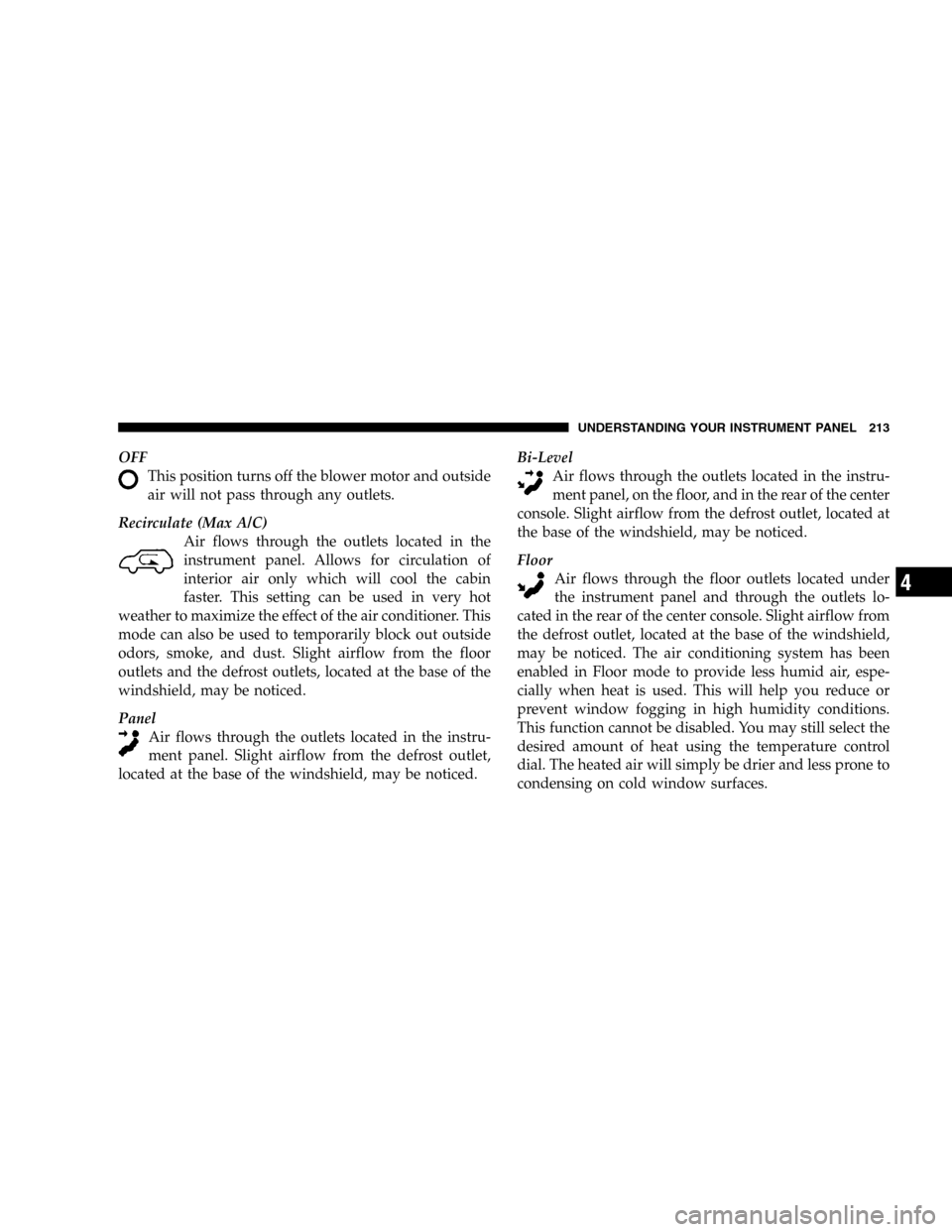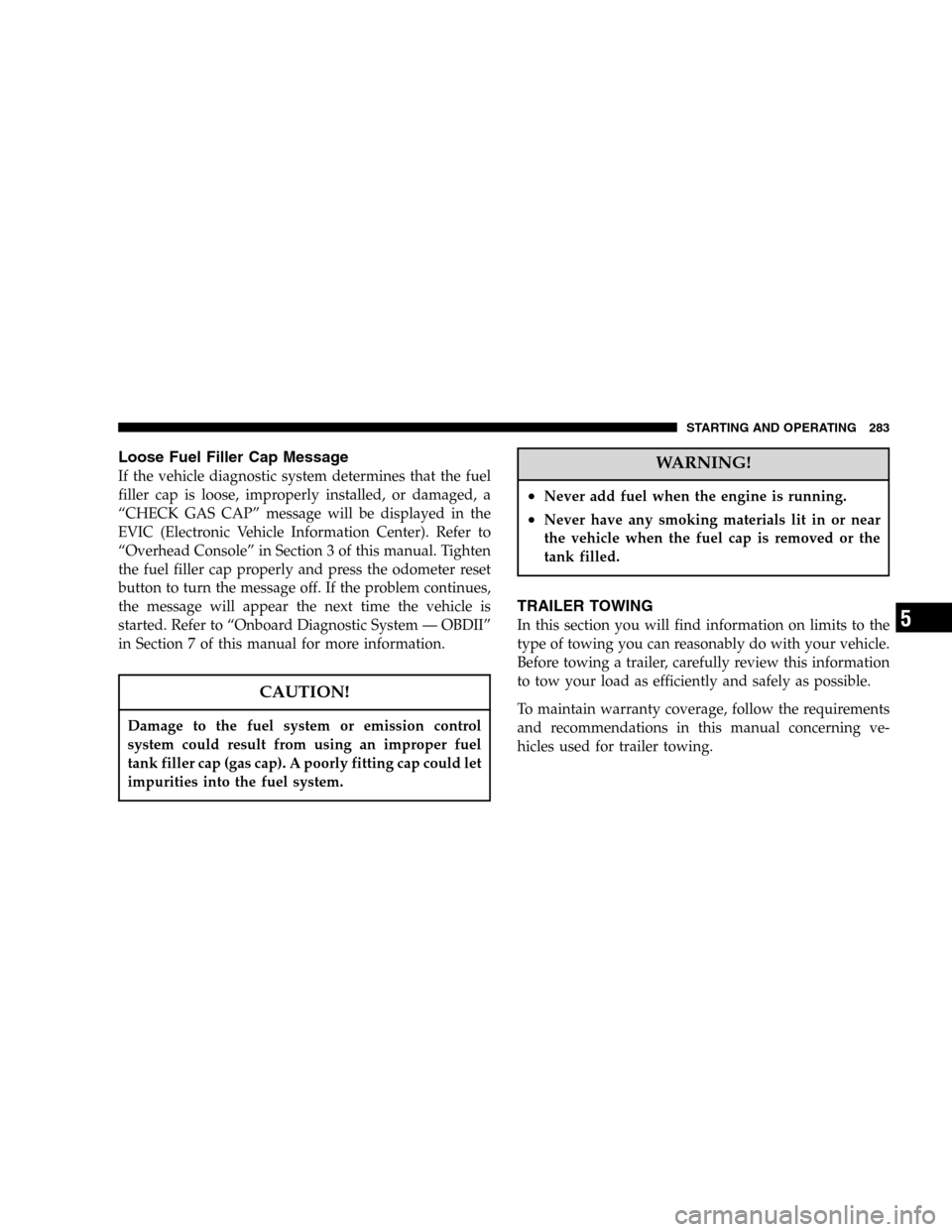Page 129 of 424

To Accelerate for Passing
Depress the accelerator as you would normally. When the
pedal is released, the vehicle will return to the set speed.
NOTE:When driving uphill, at elevations above 2,000
ft. (610 meters), or when the vehicle is heavily loaded
(especially when towing) the vehicle may slow below the
SET speed. (If the vehicle speed drops below 35 mph (56
km/h), the Speed Control will automatically disengage).
If this happens, you can push down on the accelerator
pedal to maintain the desired speed.
A full throttle (high RPM) acceleration, while the system
is engaged, will cause the system to disengage.
Vehicles may exhibit several 4-3 downshifts under the
above conditions. To reduce the frequency of the down-
shifts and to improve vehicle performance, it is advisable
to lock out overdrive. Press the O/D OFF button on the
right side of the shift lever.WARNING!
Leaving the Speed Control on when not in use is
dangerous. You could accidentally set the system or
cause it to go faster than you want. You could lose
control and have an accident. Always turn the system
off when you are not using it.
OVERHEAD CONSOLE — IF EQUIPPED
The overhead console contains dome/reading lights, an
optional universal garage door opener (HomeLink�), an
optional sunroof switch, and an Electronic Vehicle Infor-
mation Center (EVIC) that consists of the following:
•Compass/temperature display
•Trip information displays
•Vehicle information warning message displays
•Customer programmable features
UNDERSTANDING THE FEATURES OF YOUR VEHICLE 129
3
Page 150 of 424
CUP HOLDERS
In the center console there are two cup holders for the
front seat passengers.
NOTE:The front cup holder insert is removable from
the console, for cleaning.
Smoker’s Package — If Equipped
With the optional Smoker’s package, a removable ash
tray is inserted into the front cup holder location.
The rear passengers have access to a cup holder on each
rear door trim panel.
Front Cup Holders
Rear Cup Holders
150 UNDERSTANDING THE FEATURES OF YOUR VEHICLE
Page 171 of 424

11. Temperature Gage
Indicates engine coolant temperature. Any read-
ing within the normal range indicates that the
cooling system is operating satisfactorily.
The gage pointer will likely indicate a higher temperature
(above center scale) when driving in hot weather, up
mountain grades, in heavy stop and go traffic, or when
towing a trailer. It should not be allowed to exceed the
upper limits of the normal operating range.
If the pointer rises to the red zone (five chimes will
occur), pull over and stop the vehicle. Do not turn the
engine off. Idle the vehicle with the air conditioning
turned off, until the pointer drops back into the normal
range. If the engine remains in the high range, turn the
engine off and call for service.12. Reset Button
Press this button to toggle between the odometer and trip
odometer display. When in the trip odometer mode,
holding the button in resets the trip odometer. Also,
pressing the “Reset” button will clear out any warning
messages in the odometer display.
13. Odometer/Trip Odometer
A vacuum fluorescent display indicates the total distance
the vehicle has been driven. Also, the cluster will display,
replacing the odometer/trip odometer, vehicle warning
messages such as: door/gate/glass ajar and low washer
fluid. See appropriate sections for more information.
NOTE:If vehicle is equipped with the optional Elec-
tronic Vehicle Information Center (EVIC) in the overhead
console, all warnings including “door”, “GATE”,
“GLASS”, and “LOWASH” will only be displayed in the
UNDERSTANDING YOUR INSTRUMENT PANEL 171
4
Page 213 of 424

OFF
This position turns off the blower motor and outside
air will not pass through any outlets.
Recirculate (Max A/C)
Air flows through the outlets located in the
instrument panel. Allows for circulation of
interior air only which will cool the cabin
faster. This setting can be used in very hot
weather to maximize the effect of the air conditioner. This
mode can also be used to temporarily block out outside
odors, smoke, and dust. Slight airflow from the floor
outlets and the defrost outlets, located at the base of the
windshield, may be noticed.
Panel
Air flows through the outlets located in the instru-
ment panel. Slight airflow from the defrost outlet,
located at the base of the windshield, may be noticed.Bi-Level
Air flows through the outlets located in the instru-
ment panel, on the floor, and in the rear of the center
console. Slight airflow from the defrost outlet, located at
the base of the windshield, may be noticed.
Floor
Air flows through the floor outlets located under
the instrument panel and through the outlets lo-
cated in the rear of the center console. Slight airflow from
the defrost outlet, located at the base of the windshield,
may be noticed. The air conditioning system has been
enabled in Floor mode to provide less humid air, espe-
cially when heat is used. This will help you reduce or
prevent window fogging in high humidity conditions.
This function cannot be disabled. You may still select the
desired amount of heat using the temperature control
dial. The heated air will simply be drier and less prone to
condensing on cold window surfaces.
UNDERSTANDING YOUR INSTRUMENT PANEL 213
4
Page 283 of 424

Loose Fuel Filler Cap Message
If the vehicle diagnostic system determines that the fuel
filler cap is loose, improperly installed, or damaged, a
“CHECK GAS CAP” message will be displayed in the
EVIC (Electronic Vehicle Information Center). Refer to
“Overhead Console” in Section 3 of this manual. Tighten
the fuel filler cap properly and press the odometer reset
button to turn the message off. If the problem continues,
the message will appear the next time the vehicle is
started. Refer to “Onboard Diagnostic System — OBDII”
in Section 7 of this manual for more information.
CAUTION!
Damage to the fuel system or emission control
system could result from using an improper fuel
tank filler cap (gas cap). A poorly fitting cap could let
impurities into the fuel system.
WARNING!
•Never add fuel when the engine is running.
•Never have any smoking materials lit in or near
the vehicle when the fuel cap is removed or the
tank filled.
TRAILER TOWING
In this section you will find information on limits to the
type of towing you can reasonably do with your vehicle.
Before towing a trailer, carefully review this information
to tow your load as efficiently and safely as possible.
To maintain warranty coverage, follow the requirements
and recommendations in this manual concerning ve-
hicles used for trailer towing.
STARTING AND OPERATING 283
5
Page 402 of 424

Caution, Exhaust Gas...................73,141
CD Changer........................187,193
CD Player..................184,189,191,195,198
CD Player Maintenance................... 211
Cellular Phone........................85,211
Center High Mounted Stop Light............ 355
Chains, Tire............................ 274
Changing A Flat Tire..................... 294
Charging System Light.................... 170
Chart, Tire Sizing........................ 255
Check Engine Light (Malfunction Indicator Light) . 310
Child Restraint......................63,68,70
Child Restraint Tether Anchors.............67,68
Child Safety Locks........................ 24
Climate Control......................... 212
Clock................................ 176
Clutch Interlocking Ignition System........220,229
Command-Trac Operation.................. 236
Compact Disc Maintenance................. 211Compact Disc Player..................178,184
Compass.............................. 137
Compass Calibration..................... 137
Compass Variance....................... 138
Computer, Trip/Travel.................... 135
Console, Overhead....................... 129
Contract, Service........................ 392
Converter, Catalytic...................... 317
Cool Down, Turbo....................... 224
Cooling System......................... 325
Adding Coolant (Antifreeze).............. 327
Coolant Capacity...................... 356
Coolant Level......................... 328
Disposal of Used Coolant................ 328
Drain, Flush, and Refill.................. 326
Inspection........................... 325
Points to Remember.................... 329
Pressure Cap......................... 327
Radiator Cap......................... 327
402 INDEX